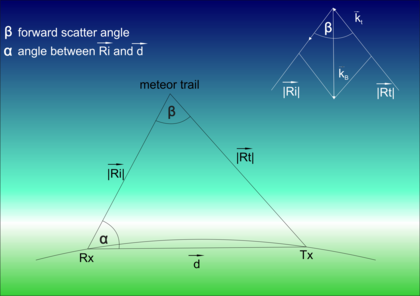Specular Meteor Radar Networks
Meteor radars are a reliable and widely spread tool to investigate MLT dynamics. Those radars make use of the reflection of electromagnetic waves at meteor trails. These radars provide observations of mesospheric winds in the altitude range between 80 to 100 km with a reasonable temporal resolution (up to 1 hour) or to estimate the mesopause region temperature by measuring the ambiploar diffusion of the meteor trail. These systems usually consist of one transmitting antenna and a receiving array of 5 antennas to determine the position of the meteor trail (specular point along the trail) in the sky by applying interferometry. The IAP operates such meteor radars in Andenes (Norway) and Juliusruh (Germany).

Due to the forward scattering angle beta between the incident and reflected radar wave also changes the Bragg wavelength.
The MMARIA (Multistatic/Multifrequency Agile Radar for Investigations of the Atmosphere) concept developed at the IAP in recent years (Stober and Chau, 2015) and its further development SIMONe (Spread-spectrum Interferometric multistatic Meteor radar Observing Network) have been implemented in recent years by commissioning meteor radar networks in Germany, Norway and South America. MMARIA and SIMONe represent an extension of traditional meteor radar systems by adding either several spatially separated receivers to existing transmitting stations or several spatially separated transmitters to existing interferometric receiving stations (Chau et al., 2019). The principle of forward scattering allows almost the same area volume to be observed from different angles (Chau et al., 2017). A further advantage is that an increased number of meteors per time unit can be detected using the same transmitter, which is a cost-effective addition to existing meteor radar equipment.
In addition to the monostatic meteor radars Juliusruh (IAP, 32.55 MHz) and Collm (University of Leipzig, 36.2 MHz), the MMARIA network Germany also includes further IAP-owned multi-frequency receiving stations in Neustrelitz, Bornim, Juliusruh and Kühlungsborn. A total of 9 multistatic connections (2 monostatic and 7 bistatic) are thus realized, which allow both local wind measurements and the determination of horizontal wind fields in the mesosphere.
The MMARIA Network Norway is mainly realised through cooperation with the institutions operating meteor radars in Andenes, Tromsø, Alta and Kiruna. In addition, the IAP operates a five-channel reception system in Straumen, a village located about 200 km south of Andenes, which receives the forward scattered transmissions of the SMR from Andenes.
In Argentina, two five-channel receiving stations were set up in 2018 in Ushuaia and Tolhuin (Tierra del Fuego), which, in cooperation with SAAMER (Southern Argentina Agile Meteor Radar) in Rio Grande, form the first stage of the MMARIA network in South America. In a next step, the first SIMONe system was installed in the province of Santa Cruz in 2019. The five-channel transmitter in the town of Tres Lagos consists of the SanDRA system developed at the IAP, which, in combination with commercial amplifier technology, transmits continuous coded CW signals. The signals reflected by the meteor tracks are currently registered at 5 locations at a distance of up to 200 km. The single channel receivers used there are also based on SanDRA. To determine the position of the reflection points, the coded information of the 5 transmitters is coherently combined at each receiving site. The further determination of the horizontal winds can be done individually for the location or also combined for wind fields.
A second, similar SIMONe system, comprising a five-channel transmitter and five separate single-channel reception systems, was installed in Peru at the same time.

Publications
- G. Stober und J. L. Chau, A multistatic and multifrequency novel approach for specular meteor radars to improve wind measurements in the MLT region, Radio Sci., 431-442, doi:10.1002/2014RS005591, 2015.
- J. L. Chau, G. Stober, C. M. Hall, M. Tsutsumi, F. I. Laskar und P. Hoffmann, Polar mesospheric horizontal divergence and relative vorticity measurements using multiple specular meteor radars, Radio Sci., 52, 811-828, doi:10.1002/2016RS006225, 2017
- J. L. Chau, J. M. Urco, J. P. Vierinen, R. A. Volz, M. Clahsen, N. Pfeffer und J. Trautner, Novel specular meteor radar systems using coherent MIMO techniques to study the mesosphere and lower thermosphere, Atmos. Meas. Tech., 12, 2113-2127, doi:10.5194/amt-12-2113-2019, 2019.












